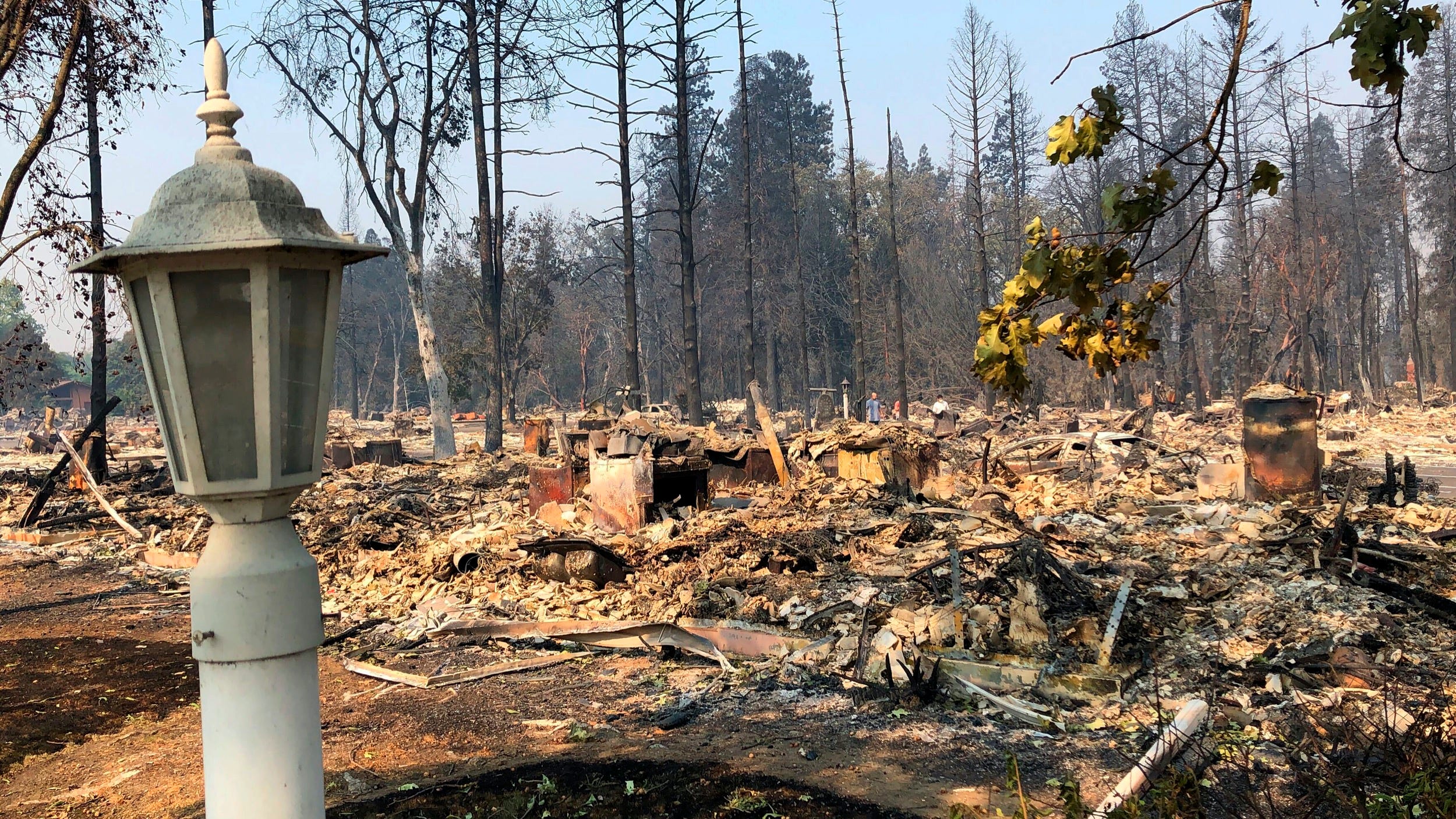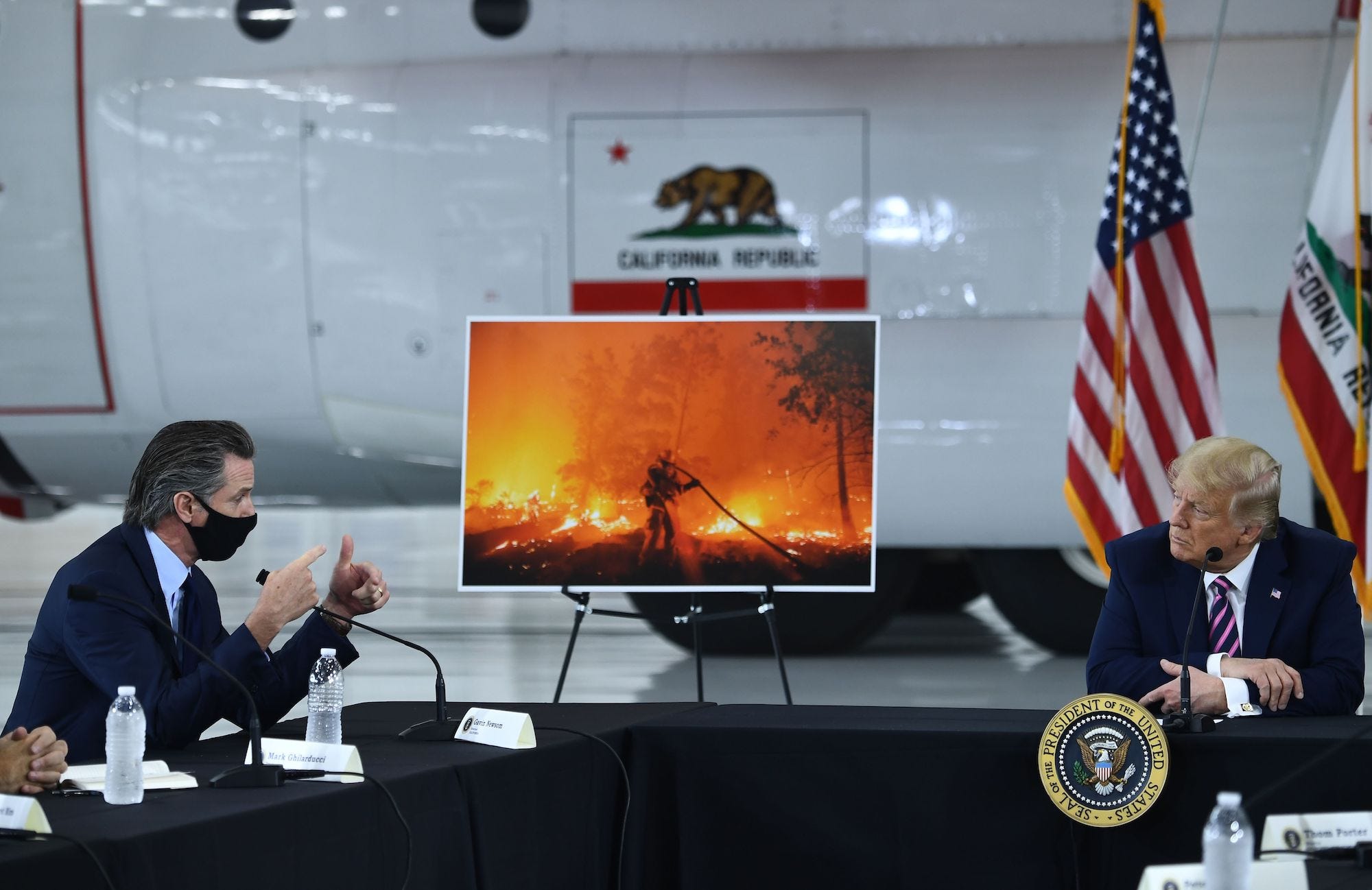
BRENDAN SMIALOWSKI/AFP via Getty Images
- In a trip to California this week, President Trump blamed California’s record-breaking wildfire season on forest mismanagement and dismissed the role of climate change.
- However, climate change has exacerbated wildfire seasons all over the world, from Australia to Alaska.
- Warming temperatures dry out soil, increase the likelihood of dry lightning, and make heat waves more common — all of which raise fire risk.
- Visit Insider’s homepage for more stories.
California’s massive wildfires have already burned more than 3.1 million acres so far this year: more than 3% of the state’s total land. The state has seen three of its four largest fires in history, and the blazes have killed at least 20 people. Two months remain in fire season.
During a trip to California this week, President Trump blamed local forest management practices for the out-of-control blazes. When Gov. Gavin Newsom’s natural-resources secretary, Wade Crowfoot, asked Trump to acknowledge climate change’s role in strengthening wildfires, the president refused.
“I don’t think science knows, actually,” Trump said.
He’s wrong. Scientific evidence suggests that climate change makes wildfires stronger and more frequent in several different ways.

Noah Berger/AP
“To cut to the chase: Were the heat wave and the lightning strikes and the dryness of the vegetation affected by global warming? Absolutely yes,” David Romps, director of the Berkeley Atmospheric Sciences Center, told MIT Technology Review in August, after lightning ignited hundreds of fires across California. “Were they made significantly hotter, more numerous, and drier because of global warming? Yes, likely yes, and yes.”
Trump is right that forest management issues contribute to California's wildfire crisis. That's largely because state and federal policies focused on suppressing fires for decades, even though most forests actually need some burning to stay healthy. (Although Trump seems to blame California's leaders for this, the federal government owns the majority of the state's forests and is thus responsible for their management.)
Forest management practices are starting to incorporate prescribed burns now.
Still, forest management practices alone cannot explain the ferocity of the California wildfire season. And they certainly can't explain why wildfires are getting larger and more destructive in other parts of the world as well.
The world is seeing more ferocious fire seasons
In the US overall, the five years in which the most acreage has burned due to wildfires have all occurred since 2005, according to the Congressional Research Service. At the same time, the country's average temperature has risen by 2.5 degrees Fahrenheit since 1970.
Beyond California, Colorado, Washington, and Oregon have all had abnormally intense fire seasons this year. Oregon has seen about 1 million acres burn as of Tuesday, nearly double the state's average from previous years, according to Gov. Kate Brown.
In Colorado, meanwhile at least 286,000 acres have burned, putting the 2020 fire season on track to become the most active in state history.

AP Photo/Gillian Flaccus
In Australia's last wildfire season, fires burned over 46 million acres across the country, an area larger than Syria. They destroyed over 5,900 structures, claimed more than two dozen human lives, and killed hundreds of millions of animals. The fires were some of the largest in the country's history.
Even the Arctic region is seeing unprecedented fires. Ten times as many large fires (blazes greater than 1,000 acres) burned there in the 2000s than in the 1950s and 1960s. The Arctic is warming twice as quickly as the rest of the world, on average.
In Alaska, 28.1 million acres burned from 2000 to 2019 – nearly double the amount of land burned from 1980 to 2000. The average area that burns during Alaska's wildfire season is expected to double again by 2050 if the world doesn't curb fossil-fuel emissions, according to the National Climate Assessment.
Warmer temperatures dry out soil
Prior to its record-breaking 2020 fire season, California saw its driest February since at least 1864. In some parts of the state, including San Francisco, not a single drop of rain fell. January was also fairly dry, and both months were hotter than usual. Snowpack in the Sierras only reached 44% of normal levels.

Satellite image ©2020 Maxar Technologies
Dry conditions in the winter lead to dry foliage in the spring and summer — prime fuel for wildfires. Higher average temperatures also dry out vegetation, even without a decrease in rainfall.
That's because as temperatures rise, more water evaporates from soil. Snow also melts sooner, and spring weather arrives earlier. In 2017, for instance, the growing season for certain widespread plants started 22 days earlier than usual in Washington, DC.
Extreme heat becomes more common
Climate change also increases the likelihood of extreme heat, which in turn can lead to more strong, hot fires. The 10 warmest years on record worldwide have all occurred since 1998, according to the National Oceanic and Atmospheric Administration.
Even a small amount of warming shifts the range of possible temperatures up, causing numbers that would previously have been extreme to become more common. Think of it like a bell curve: As the curve moves right towards higher numbers, a temperature at the extremely rare end of the curve falls closer to the middle.
"Our recent past is merely a paltry precursor to a much hotter future," Jeff Berardelli, a climate contributor for CBS News, wrote in Yale Climate Connections.
In March, researchers found that Australia's devastating wildfires in December and January happened mainly as a consequence of a prolonged heatwave in 2019. That kind of heatwave is now 10 times more likely in the region than it was in 1900. Overall, climate change made giant wildfires 30% more likely than before, the researchers concluded.
Climate change also makes lightning more frequent
Thunderstorms occur when air is warm and humid. That was the case during the heatwave that struck California in August, which was followed by a barrage of lightning that in turn started hundreds of wildfires.
Climate change makes lightning more common as well. A 2014 study found that each degree in planetary warming may increase the number of worldwide lightning strikes by 12%.

Noah Berger/AP
Fires ignited by lightning, meanwhile, are also likely to increase worldwide, according to a 2018 study, since more frequent lightning bolts strike are expected to strike drier grass and forests.
What's more, large fires are more likely to generate pyrocumulonimbus clouds that are capable of making their own weather – including, in some cases, lightning.
